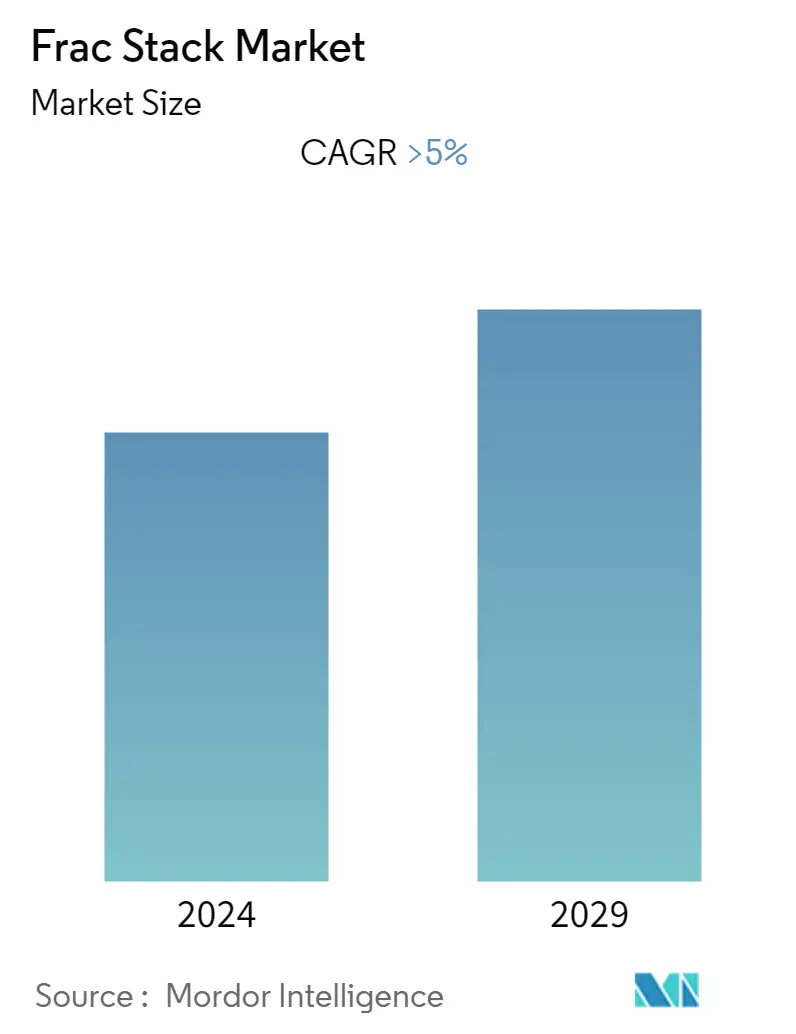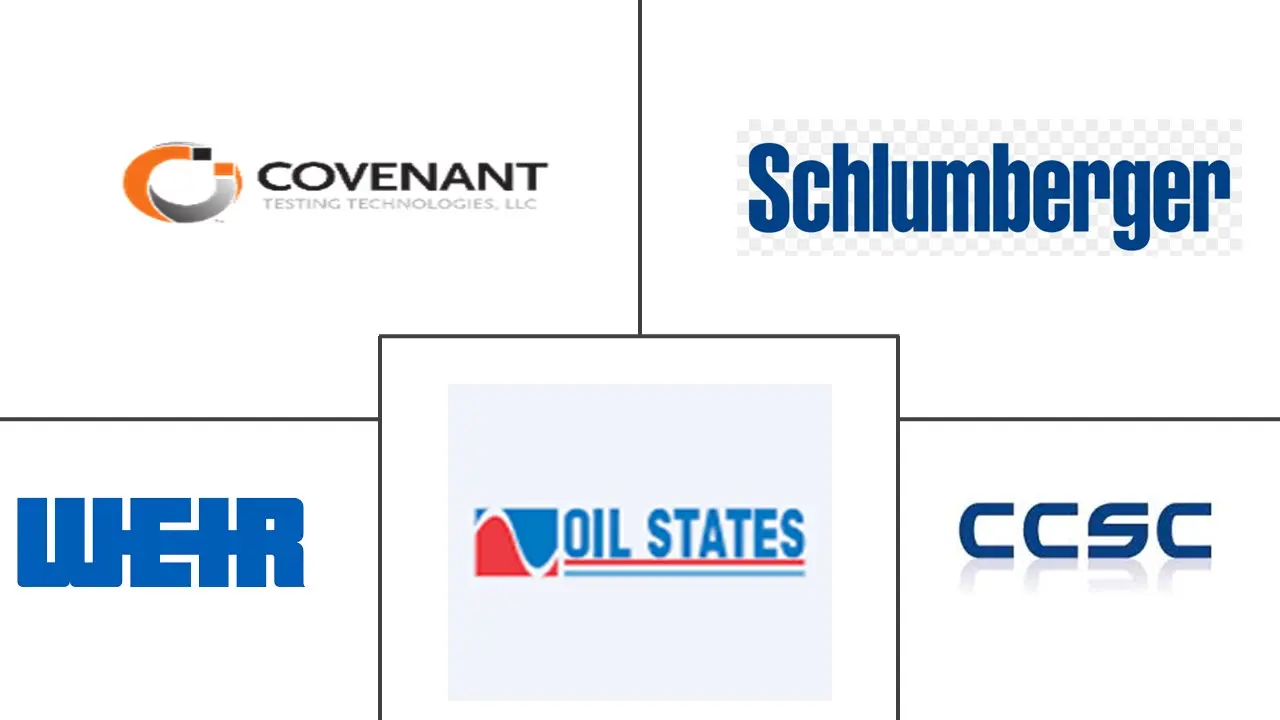Market Size of Frac Stack Industry

| Study Period | 2020 - 2029 |
| Base Year For Estimation | 2023 |
| CAGR | > 5.00 % |
| Fastest Growing Market | Asia Pacific |
| Largest Market | North America |
| Market Concentration | Medium |
Major Players
*Disclaimer: Major Players sorted in no particular order |
Frac Stack Market Analysis
The frac stack market is expected to register a CAGR of more than 5% during the period from 2022 to 2027. As global oil prices fell enormously during the COVID-19 pandemic, the frac stack and fracking market suffered immensely, as most producers halted fracking operations due to lower oil prices. There is rising production from unconventional resources, as most of the conventional oil fields are aging at a faster rate and will not be able to meet the growing energy demand. This is expected to drive the frac stack market during the forecast period. Additionally, the shale boom in the United States, which has led to massive growth in production volumes and the commercialization of fracking technology, has reduced the capital costs of fracking operations globally, which is expected to drive the market during the forecast period. However, environmental concerns and a lack of capital market and incentives are restraining the market growth.
- The onshore sector has accounted for around 70% of the global crude oil production. The demand for fracturing is growing to maintain or increase production from existing fields and the increasing popularity of unconventional reserves such as shale and tight ones. As hydraulic fracturing increases in the onshore sector, the frac stack market is expected to get larger.
- The application of the Internet of Things (IoT) to use a large amount of data generated during the exploration and production (E&P) activities has led to a growing demand for safety concerns and improving the efficiency of the fracking process using advanced analytics and simulation software. The application of big data analytics and IoT systems in fracking operations is expected to lead to significant growth opportunities for the frac stack market in the coming years.
- North America is one of the largest markets for frac stacks, led by the United States, primarily due to the shale boom, which has led to the increased exploitation of its shale reserves that need to be fractured for economical production.
Frac Stack Industry Segmentation
The frac stack market report includes:
| Location of Deployment | |
| Onshore | |
| Offshore |
| Well Type | |
| Horizontal and Deviated | |
| Vertical |
| Geography | |
| North America | |
| Europe | |
| Asia-Pacific | |
| South America | |
| Middle-East and Africa |
Frac Stack Market Size Summary
The frac stack market is poised for growth, driven by the increasing demand for hydraulic fracturing to enhance oil and gas recovery from both conventional and unconventional reservoirs. As conventional oil fields age and struggle to meet rising energy demands, the focus has shifted towards unconventional resources, such as shale and tight gas reserves. This shift is further supported by the shale boom in the United States, which has significantly reduced the capital costs associated with fracking operations globally. However, the market faces challenges from environmental concerns and a lack of capital market incentives, which could potentially hinder its growth trajectory. The application of advanced technologies like IoT and big data analytics is expected to create substantial opportunities for enhancing the efficiency and safety of fracking processes, thereby bolstering market expansion.
North America, particularly the United States, remains a dominant player in the frac stack market due to its extensive shale reserves and ongoing exploitation efforts. The region's mature fracking sector, coupled with robust domestic demand and well-established hydrocarbon export infrastructure, positions it as a key market during the forecast period. Despite the economic recovery post-COVID-19 and rising oil prices, the market faces regulatory challenges related to health, safety, and environmental concerns, which have increased operational costs. Meanwhile, international markets, such as China and Saudi Arabia, are also witnessing a rise in fracking activities, contributing to the global demand for frac stacks. The market is moderately consolidated, with key players actively engaging in strategic acquisitions and mergers to strengthen their market positions.
Frac Stack Market Size - Table of Contents
-
1. MARKET OVERVIEW
-
1.1 Introduction
-
1.2 Market Size and Demand Forecast in USD billion, till 2027
-
1.3 Recent Trends and Developments
-
1.4 Government Policies and Regulations
-
1.5 Market Dynamics
-
1.5.1 Drivers
-
1.5.2 Restraints
-
-
1.6 Supply Chain Analysis
-
1.7 Porter's Five Forces Analysis
-
1.7.1 Bargaining Power of Suppliers
-
1.7.2 Bargaining Power of Consumers
-
1.7.3 Threat of New Entrants
-
1.7.4 Threat of Substitute Products and Services
-
1.7.5 Intensity of Competitive Rivalry
-
-
-
2. MARKET SEGMENTATION
-
2.1 Location of Deployment
-
2.1.1 Onshore
-
2.1.2 Offshore
-
-
2.2 Well Type
-
2.2.1 Horizontal and Deviated
-
2.2.2 Vertical
-
-
2.3 Geography
-
2.3.1 North America
-
2.3.2 Europe
-
2.3.3 Asia-Pacific
-
2.3.4 South America
-
2.3.5 Middle-East and Africa
-
-
Frac Stack Market Size FAQs
What is the current Frac Stack Market size?
The Frac Stack Market is projected to register a CAGR of greater than 5% during the forecast period (2024-2029)
Who are the key players in Frac Stack Market?
Oil States Energy Services, CCSC Petroleum Equipment Ltd Co, Schlumberger Limited, The Weir Group PLC and Covenant Testing Technologies LLC are the major companies operating in the Frac Stack Market.

